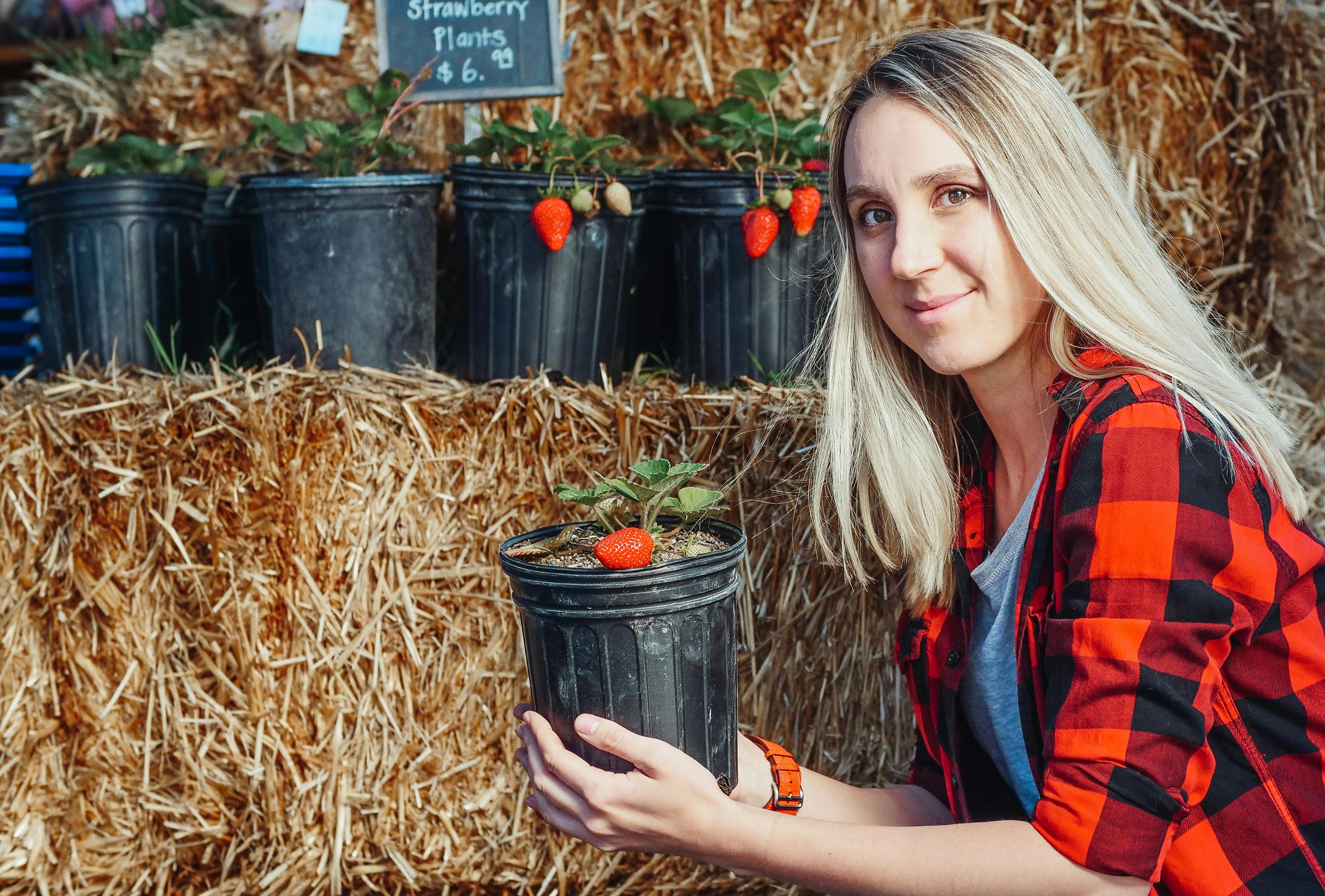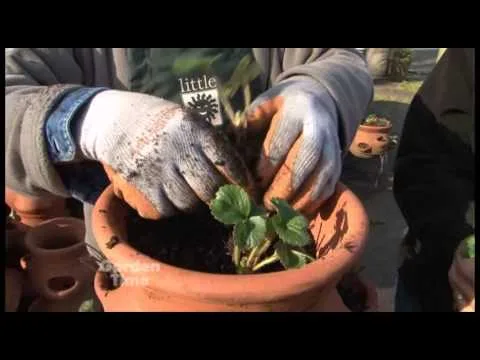Planting in a strawberry pot is a great way to maximize the amount of space you have for growing plants. It can also be an attractive addition to any home garden. With a few simple steps, you can easily plant and grow your own strawberry pot. This guide will walk you through the process of how to plant in a strawberry pot, from choosing the right pot to taking care of your plants.1. Start by purchasing a strawberry pot or potting a terracotta pot to be used as a strawberry pot.
2. Fill the pot with good quality potting soil, leaving about an inch of space from the top of the pot.
3. Plant your strawberry plants at least 4 inches apart in the soil, making sure to spread out the roots evenly in all directions.
4. Gently press down on the soil around each plant to make sure they are firmly planted in the ground.
5. Water your plants well and place them in an area that receives at least 6 hours of sunlight per day.
6. To help keep your soil moist, add a light layer of mulch around your plants and water regularly throughout the growing season.
7. After about three weeks, you may begin to see flowers appear on your strawberry plants and shortly after that, you should have delicious strawberries ready for harvesting!
Choosing the Best Pot for Planting
Selecting the best pot for planting can be a daunting task, as there are various sizes and materials available on the market. It is important to choose the right pot for your plant, as this will determine how healthy and strong it will be. Before you decide on a specific pot, there are several factors to consider such as size, material and drainage.
When it comes to size, it is important to ensure that the pot you select is large enough to accommodate the plant’s root system. If the pot is too small, your plant may become root-bound and unable to absorb enough water and nutrients. On the other hand, if you choose a pot that is too large, this can cause waterlogging and other problems such as root rot. Therefore, it is important to choose a pot that is just right for your particular plant.
The material of your pot also makes a difference when selecting the best one for planting. The most common materials used include terracotta clay pots, plastic pots or wooden boxes. Each material has its own set of advantages and disadvantages; terracotta clay pots are porous which allows air circulation and evaporation of excess water but they tend to dry out quickly so frequent watering may be necessary; plastic pots are lightweight and come in a variety of colors but they do not allow air circulation; wooden boxes are usually more expensive than other types of pots but they provide better drainage.
Finally, make sure you consider drainage when choosing a pot for planting. Good drainage ensures that excess water can escape from the soil and prevents waterlogging which can lead to poor root growth or even death of the plant. Different types of pots have different levels of drainage; terracotta clay pots generally have good drainage while plastic or wooden boxes may need additional holes in them in order to achieve adequate drainage levels.
By considering all these factors carefully before choosing a particular pot for planting, you can ensure that your plants will thrive in their new home!
Preparing The Soil for Planting
Proper soil preparation is essential for a successful garden. Preparing the soil before planting will ensure the best possible results and help promote healthy plant growth. It is important to prepare the soil correctly to improve the fertility and texture of the soil, and to ensure proper drainage. To properly prepare the soil for planting, it is important to take time to assess the existing soil conditions and amend the soil as necessary.
The first step in preparing the soil for planting is to test its pH level. A pH test will determine if the soil is acidic or alkaline, which will affect how certain plants grow. If necessary, add lime or sulfur to alter the pH of the soil in order to create an optimal environment for your plants.
Next, turn over or loosen up the top layer of the soil with a shovel or garden fork. This will help improve air circulation in the soil, which can help promote healthy root growth. It also helps break up any compacted areas of dirt, which can impede water absorption and root growth.
Once you have loosened up the top layer of dirt, add organic matter such as compost, manure, leaves or grass clippings to enrich and improve fertility levels in your garden bed. This will help provide essential nutrients for your plants and help retain moisture in your garden bed.
Finally, rake out any large stones or debris from your garden bed before planting seeds or seedlings. These materials can inhibit root growth and impede water absorption. After you have finished preparing your garden bed, it is now ready for planting!
Picking The Right Strawberries to Plant
Picking the right strawberry to plant is key to ensuring a good harvest. Strawberries come in many shapes, sizes and varieties, so it’s important to understand what type of strawberry will best suit your garden and climate conditions. Selecting the right variety for your garden will also help ensure that your plants are disease and pest resistant.
When selecting a strawberry variety, you should consider the size of the fruit, its flavor, how long it takes to ripen, and how large or small the plant is. It’s also important to take into account any special requirements for pollination or disease resistance. Most strawberries require both male and female flowers for pollination and some varieties are more disease resistant than others.
You should also consider the size of the garden space available when selecting a variety of strawberry. Dwarf varieties tend to be better suited for smaller gardens as they don’t require as much room as larger varieties do. Additionally, some dwarf varieties produce larger fruits than others so you should choose one that suits your needs best.
Finally, you should consider how long it takes for each variety of strawberry to ripen before picking a variety. Certain types can take up to four weeks before they are ready for harvesting while others can ripen in just a few days. Knowing this information can help you choose a variety that fits into your harvest schedule and ensures that you have ripe strawberries when you need them most!
By taking all these factors into consideration when selecting a type of strawberry to plant, you can ensure that you have the best chance of having an abundant harvest of delicious strawberries.
Spacing Requirements for Planting
When planning a planting project, it is important to consider the spacing requirements of the plants that will be used. The amount of space needed will depend on the size and type of plant being planted. For smaller plants such as flowers, herbs, and shrubs, a spacing distance of 6-12 inches should be used. For larger plants such as trees or vines, the spacing distance should be 18-36 inches. If multiple plants are being planted in a row, then the total width for all the plants should be taken into account when determining spacing distances. Additionally, if different types of plants are being used together in a planting project, it is important to consider their individual growth patterns and root systems in order to determine how much space is needed between them. When planning a planting project with multiple species of plants, it is recommended to allow for more space between them than if only one type of plant was being planted.
It is also important to consider soil conditions when determining spacing requirements for planting projects. In areas where soil is dense or clay-like, it is best to use more space between plants than in areas with loose soil or sand-like conditions. By allowing more room between plants in areas with compacted soils, roots can spread out more easily and get adequate water and nutrients from the soil which can help prevent overcrowding and reduce competition between the different species.
Finally, when planning a planting project, it is important to think about future growth needs as well. Planting too close together can cause overcrowding once the plants mature which can stunt their growth and limit access to resources such as sunlight or water. By considering all these factors before starting your planting project you can ensure that your plants have adequate space to grow healthy and strong!

Watering Requirements for Strawberries
Strawberries require regular watering to remain healthy and productive. An adequate supply of water should be available at all times during the growing season, especially during times of drought. Watering should be done deeply and less often, as opposed to shallow and frequent, to promote a strong root system. The soil should be kept evenly moist but not overly wet. Too much water can cause the fruit to become soggy or rot. During hot weather, it may be necessary to water every day or even twice a day if the soil is drying out quickly. Watering should be done early in the morning so that plants have time to dry out before evening. It’s also important to check for proper drainage, as strawberries don’t like wet feet and can develop root rot if there isn’t good drainage in their location. Mulching around the plants can help reduce moisture loss from the soil.
Overall, strawberries need about an inch of water per week during their active growth season and even more in hot weather or periods of drought. Regularly monitoring soil moisture is an effective way of determining when it’s time to water again, as is regularly inspecting the plants for signs of wilting or discoloration in their leaves. Watering requirements will vary depending on weather conditions, type of soil, and other factors so it’s important to observe how your plants react in order to provide them with optimal care and ensure a bountiful harvest!
Feeding Your Strawberry Plants
Strawberry plants are a great addition to any garden and are incredibly easy to care for. However, there are some key points that you should keep in mind when it comes to feeding your strawberry plants. To ensure that they stay healthy and produce delicious fruit, you should provide them with the proper nutrients throughout the growing season.
The first step in caring for your strawberry plants is to make sure that they get enough sunlight. They should be placed in an area that receives at least 6-8 hours of direct sunlight per day. This will help ensure that the plants get enough energy to grow and produce fruit.
Next, it’s important to provide your strawberry plants with the right kind of soil. You want a soil that has good drainage and is rich in organic matter. This will help provide your strawberries with the nutrients they need to thrive. You may also want to consider adding a slow-release fertilizer or compost into the soil around your strawberry plants to give them an extra boost of nutrition.
Finally, you should make sure to water your strawberry plants regularly throughout the growing season. It’s important to keep the soil moist but not overly wet as this can lead to fungal diseases or root rot. You may also want to consider applying a liquid fertilizer every few weeks during the growing season as this can help give your strawberries an extra boost of nutrition as well.
By following these steps, you can ensure that your strawberry plants stay healthy and productive throughout the growing season!
Mulching Your Plants to Retain Moisture
Mulching is one of the best ways to retain moisture in your plants and soil. It helps protect your plants from extreme weather conditions and also prevents weeds from taking over. It also provides nutrients to the soil and helps keep the temperature of the soil moderate. Mulching is a great way to conserve water and reduce water waste.
When mulching around your plants, it’s important to use an organic material that will decompose over time. This will help improve the quality of the soil as it breaks down. Some popular mulch materials include leaves, grass clippings, hay, straw, wood chips, and compost. Make sure you are not using any materials that have been treated with chemicals or pesticides as this can be harmful to your plants.
It’s also important to make sure you are applying enough mulch around your plants but not too much. Too much mulch can suffocate your plants by blocking out oxygen and light they need for survival. The ideal depth for most mulches is between 2-4 inches (5-10 cm). This will be enough to help retain moisture in the soil while still allowing adequate oxygen and light into the root system of your plants.
Finally, make sure you are checking on your mulched plants regularly to ensure they are getting enough water. If you notice any dry patches in the mulch, add some extra water until it is saturated again. Mulching is a great way to help retain moisture in your plants and conserve water at the same time!

Conclusion
Planting in a strawberry pot is a great way to maximize limited garden space. It can also be used to create a visual and edible display of fresh, delicious strawberries. With the right soil, fertilizer, and care, you can enjoy your strawberry pot for many years to come. Be sure to use the correct varieties of strawberry plants for your area and follow all planting instructions for best results.
Strawberry pots are a great way to enjoy strawberries in small spaces or even indoors. The unique look and style of these pots makes them an attractive addition to any garden or home. With proper care and maintenance, they can provide you with an abundance of fresh strawberries for many seasons!



